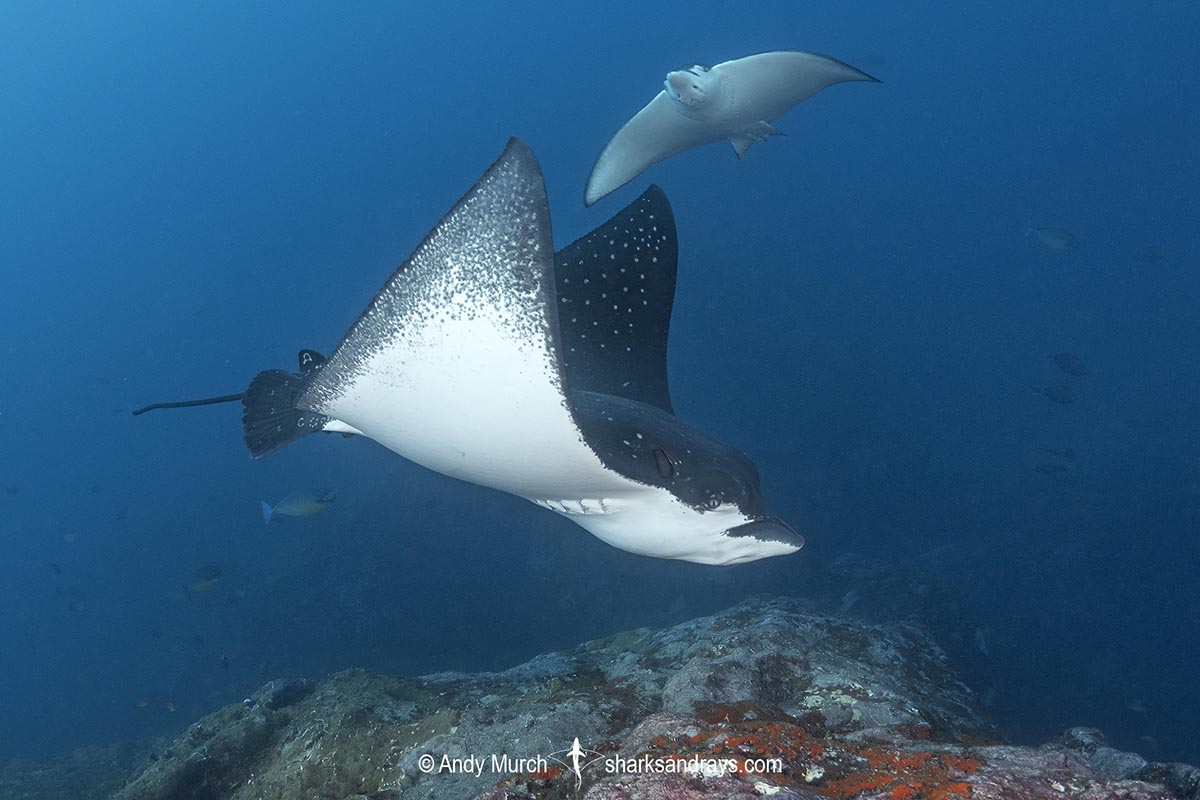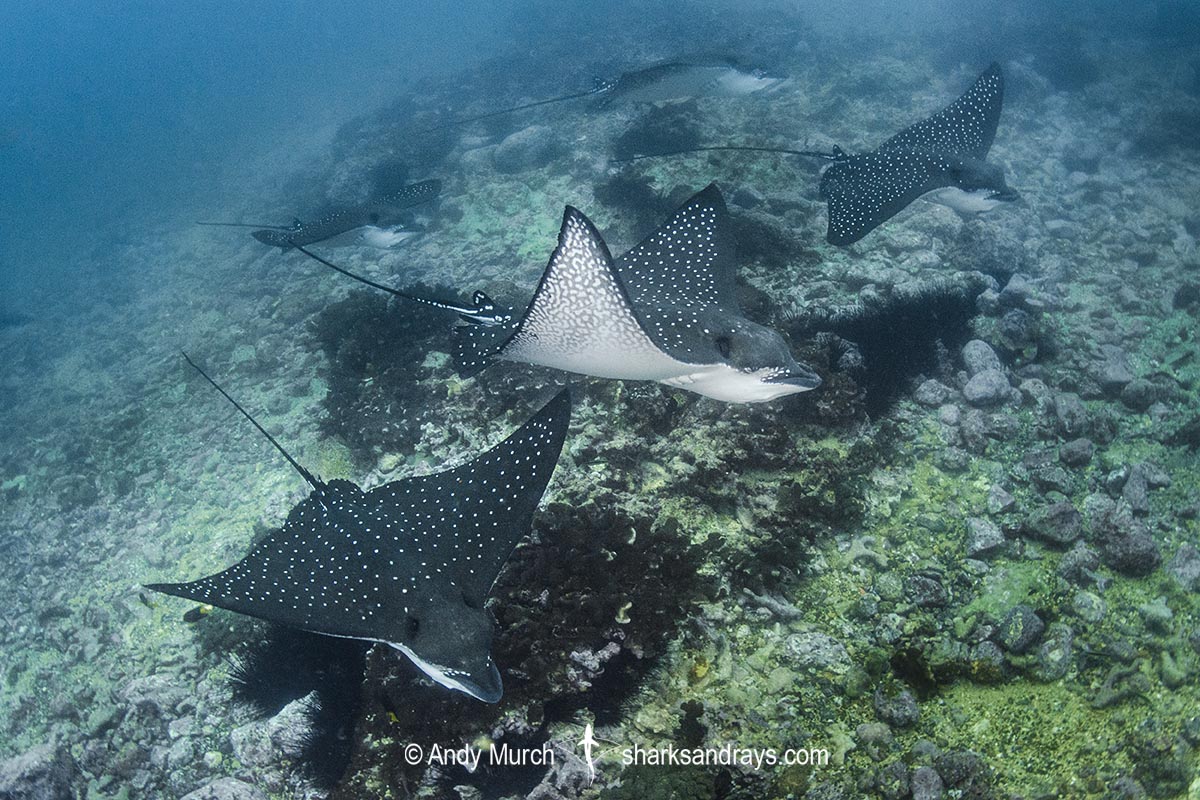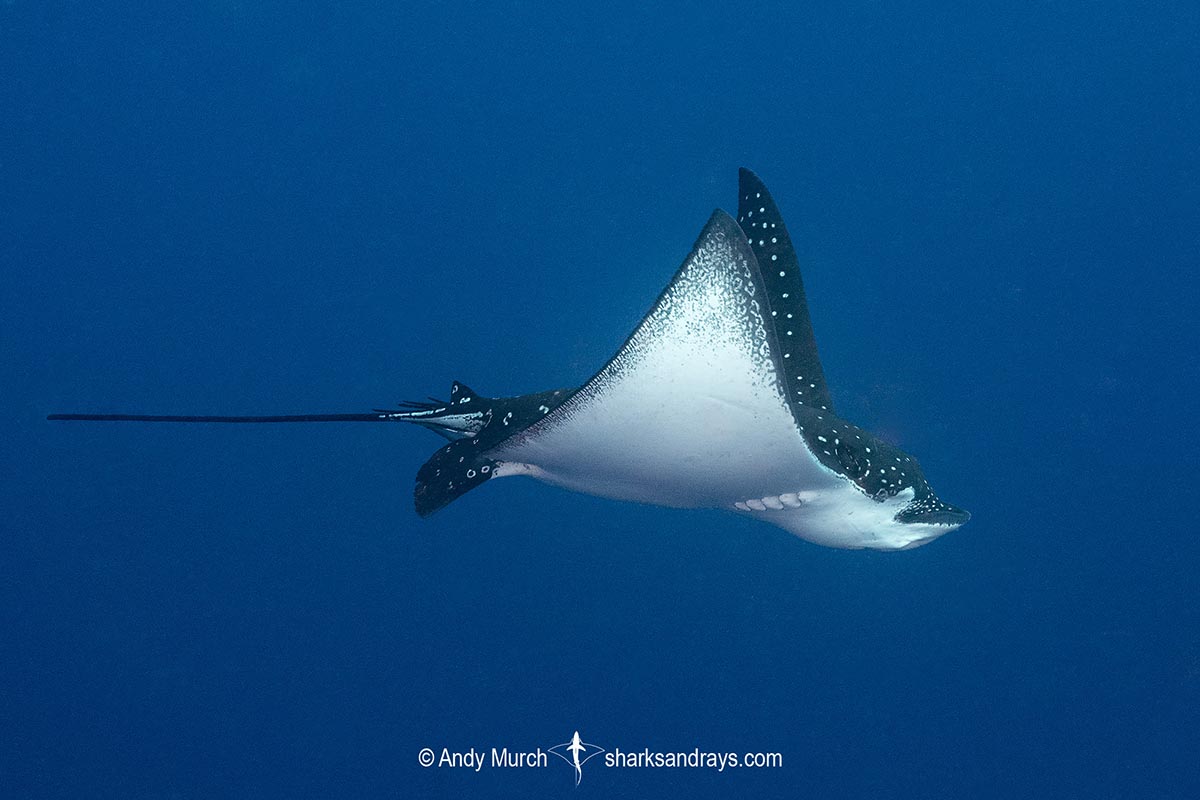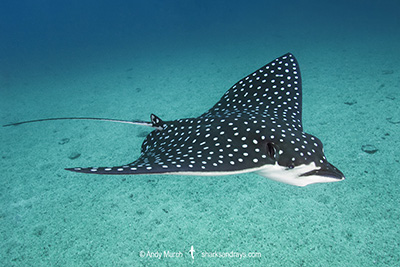Common name(s)
Ocellated Eagle Ray, Spotted Eagle Ray.
Binomial
Aetobatus ocellatus
Synonyms
Aetobatis punctatus, Aetobatus guttatus, Aetobatus ocellata, Aetobatus punctatus, Aetomylaeus ocellatus, Goniobatis meleagris, Miliobatis punctatus, Myliobatis eeltenkee, Myliobatis macroptera, Myliobatis ocellatus, Myliobatis punctatus, Myliobatus ocellatus, Pteromylaeus punctatus, Raia quinqueaculeata, Raja edentula, Raja guttata, Raja mula, Raja quinqueaculeata, Raja tajara, Raja tajara hörraeka, Stoasodon ocellatus.
Identification
A very large ray with a rhomboidal disc that is significantly wider than long; width approximately 1.5 times length. Large, protruding head with a moderately long, parabolic rostral lobe. Spiracles large. Mouth slightly narrower than pre-oral (rostral lobe) length. Nasal curtain large, with a fringed posterior margin and deep central notch. Powerful pectoral fins have straight anterior margins, concave posterior margins, and falcate, pointed apexes. Pectoral fin origin level with eyes. Dorsal fin small, with a broadly rounded apex. Disc entirely smooth; lacking thorns. Tail filamentous and long when intact. Tail length 2.1-2.5 x disc width. 1 or 2 tail spines usually present, occasionally up to five.
Colour
Dorsum slate grey, olive-grey, or almost black, with numerous small white spots or rings. Tail unmarked except close to the base. Ventrum white. Ventral surface of pectoral fin tips and margins usually darkly mottled.
Size
Maximum disc width at least 300cm. Disc width at birth highly variable 17-50cm.

Conservation Status
VULNERABLE
The Ocellated Eagle Ray is a common bycatch in a variety of net fisheries throughout its range. Many of these areas have very little fisheries management. Aetobatus ocellatus also commonly hunts in heavily polluted estuarine environments.

Habitat
Tropical/subtropical seas. Sandy bays, coral reefs, rocky outcrops, and sea mounts. Sometimes in brackish estuaries. May be close to the substrate, in midwater, or near the surface. Intertidal to at least 35m depth; probably much deeper.
Distribution
The ocellated eagle ray was previously thought to be a regional variant of a the spotted eagle ray, but the latter was recently split into at least three regional species. A. ocellatus occurs in the Indian Ocean and across most of the Pacific including the Galapagos, Malpelo, and Cocos Islands in the eastern Pacific, but it is absent from the Pacific coastline of the Americas.
Reproduction
Matrotrophic viviparity. Litter size up to 10 but ususally 4 or less.
Diet
Diet consists mainly of hard shelled, benthic invertebrates such as hermit crabs, whelks, oysters clams, and other molluscs.
Behavior
Often seen in large schools but may also be solitary.
Reaction to divers
Usually shy around scuba divers but will make close passes if not pursued; e.g. at cleaning stations.
Diving logistics
Ocellated eagle rays are quite easy to find throughout much of their range. They are virtually guaranteed at numerous dive sites in French Polynesia.
In February, ocellated eagle rays form mating agregations in deep water (40-50m) off Rangiroa Atoll. During that time, divers may also witness great hammerheads predating on them.
At current swept Matateteiko Point in Nuku Hiva, squadrons of eagle rays circle constantly to the cleaning station. Its a surge-filled area but if you find a (non-damaging) spot to hold onto, you will be rewarded with very close encounters with ocellated eagle rays.
Many years ago, I found Thailand’s Koh Bon and Rachi Noi to be good spots for eagle ray encounters but the reefs in this area have seen better days and I have not seen any recent reports.
In the Eastern Pacific, Aetobatus ocellatus is commonly seen on reef drop offs in the Galapagos, Malpelo, and Cocos Islands.
What’s new
View our full list of updates
Similar species
Pacific Eagle Ray Distinguished by pectoral fin tips without markings ventrally, and limited range along the tropical/subtropical coastline of the Americas.








